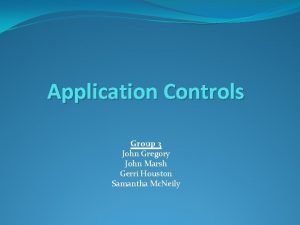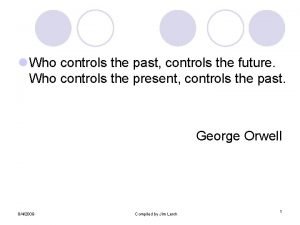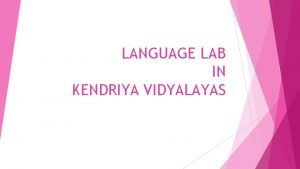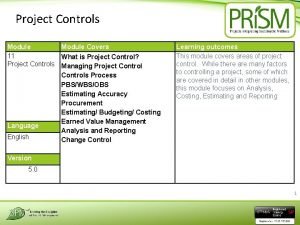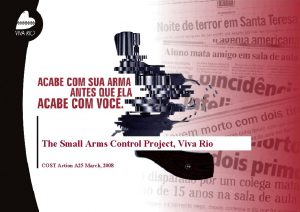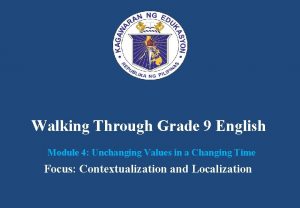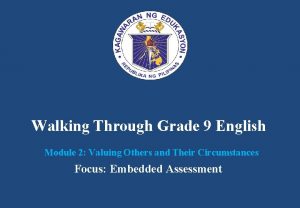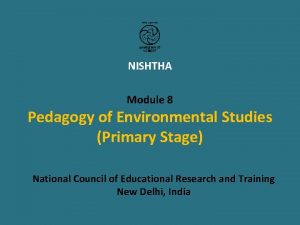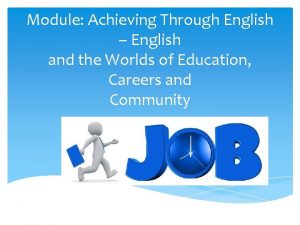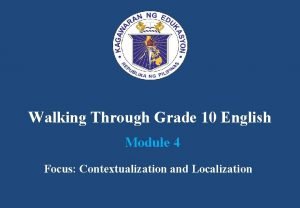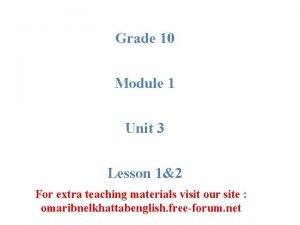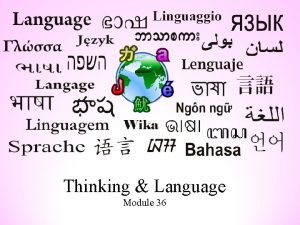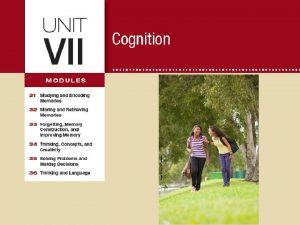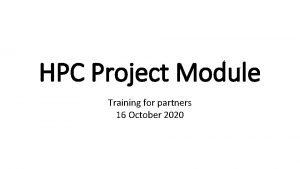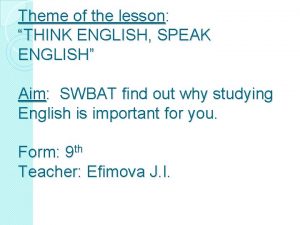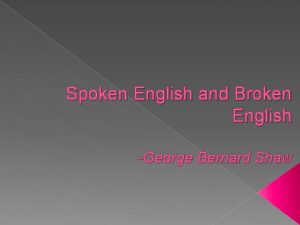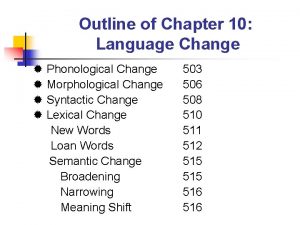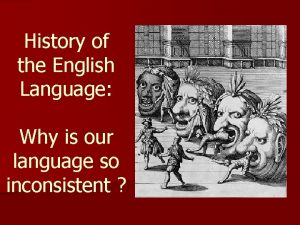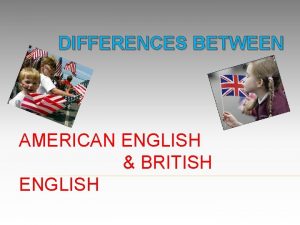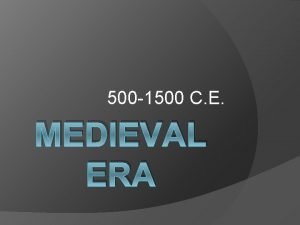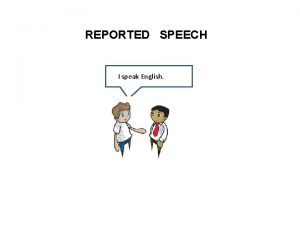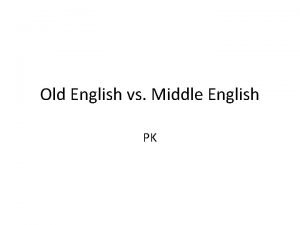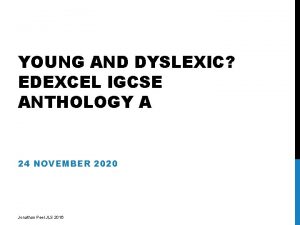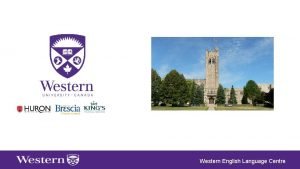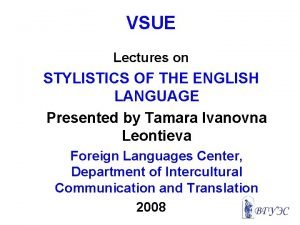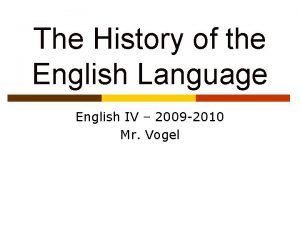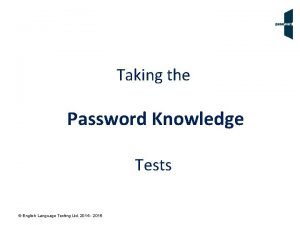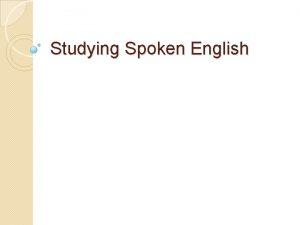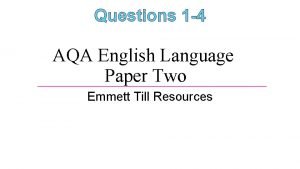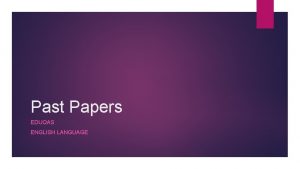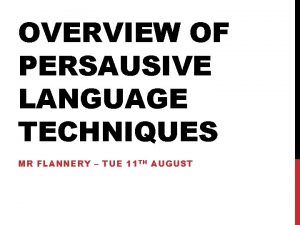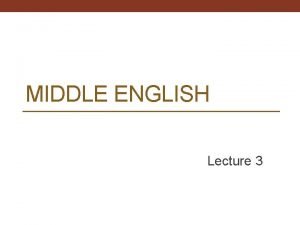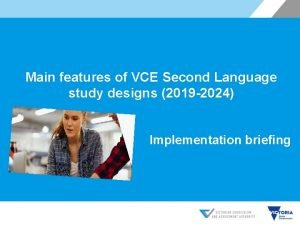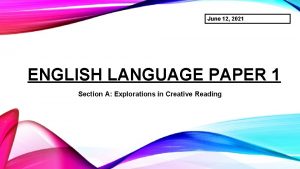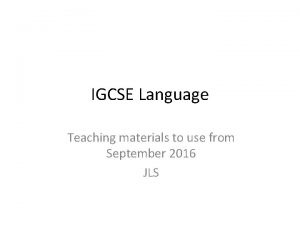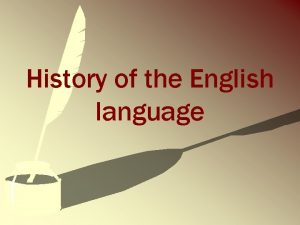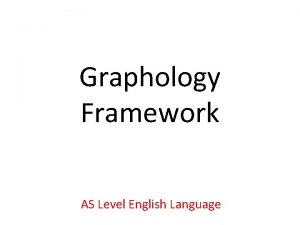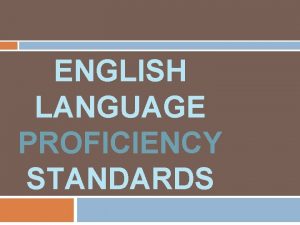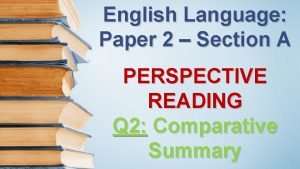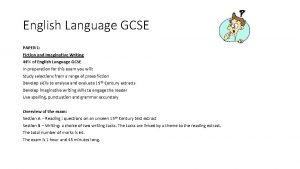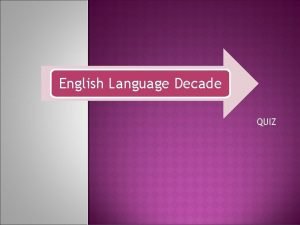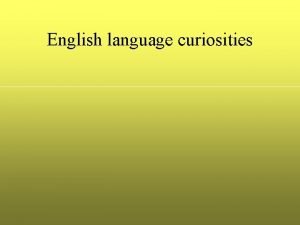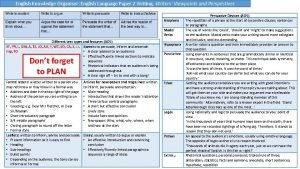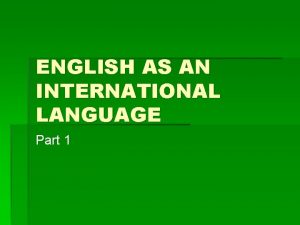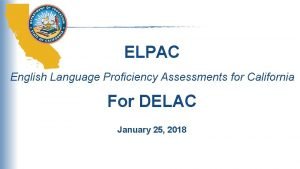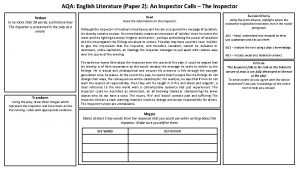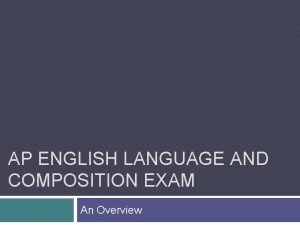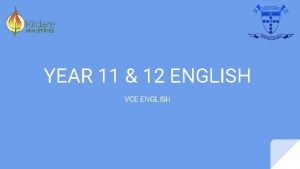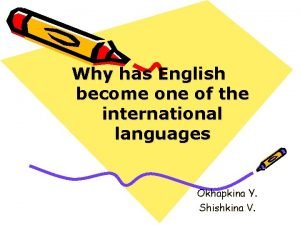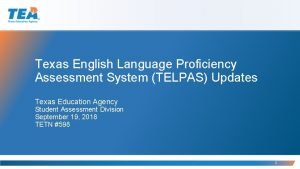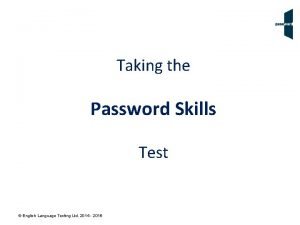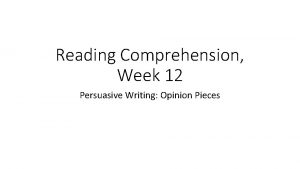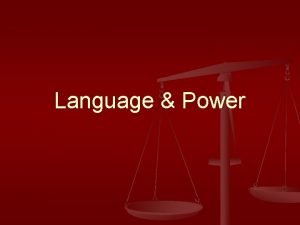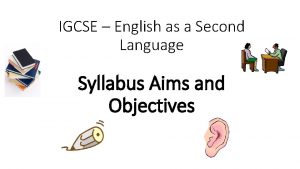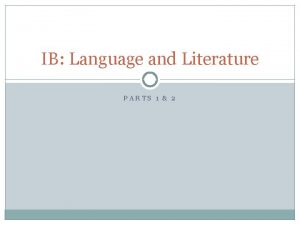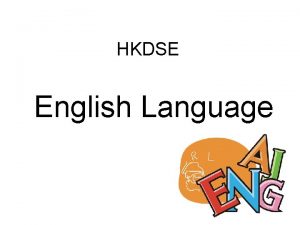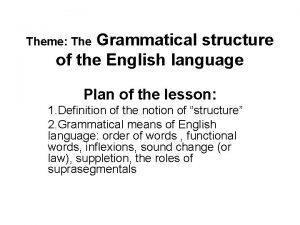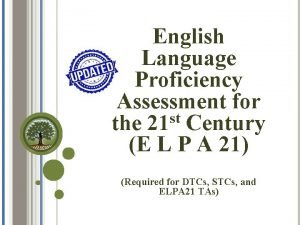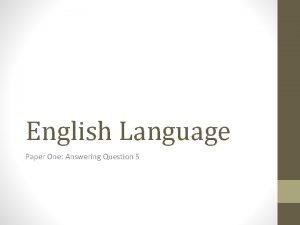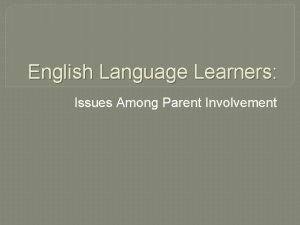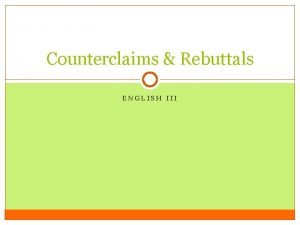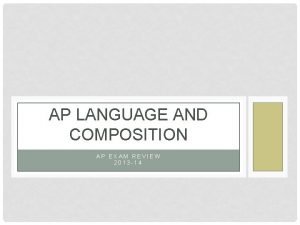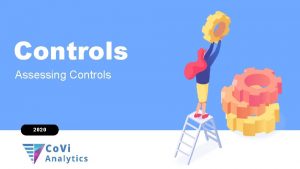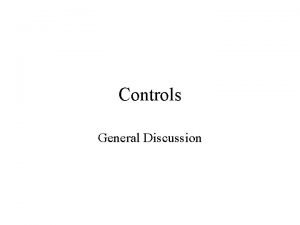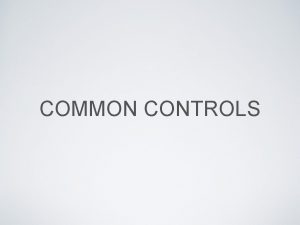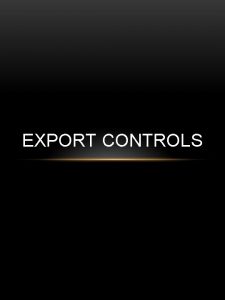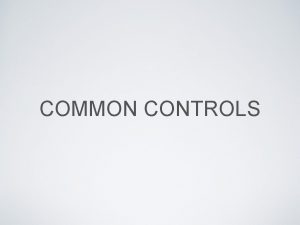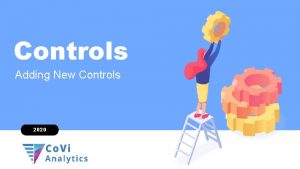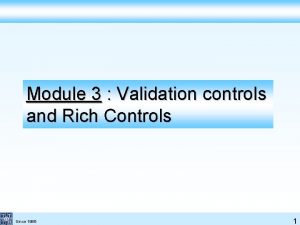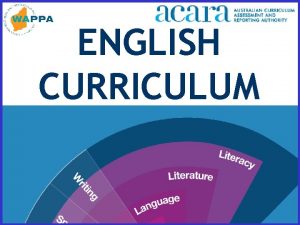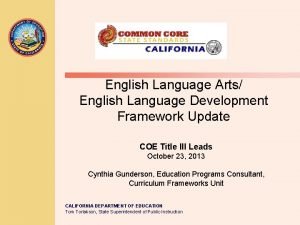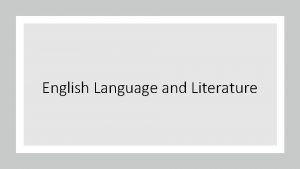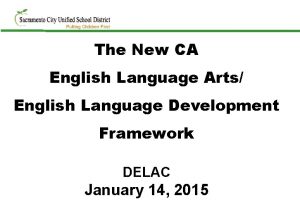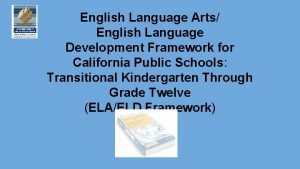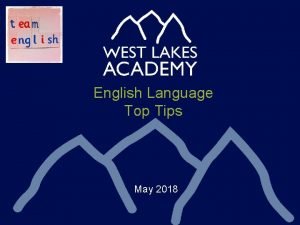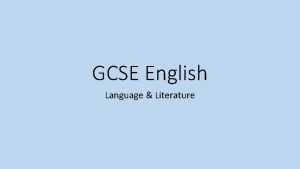Project Controls Module 11 Project Controls Language English







































































































- Slides: 103

Project Controls Module 11 Project Controls Language English Module Covers What is Project Control? Managing Project Controls Process PBS/WBS/OBS Estimating Accuracy Procurement Estimating/ Budgeting/ Costing Earned Value Management Analysis and Reporting Change Control Learning outcomes This module covers areas of project control. While there are many factors to controlling a project, some of which are covered in detail in other modules, this module focuses on Analysis, Costing, Estimating and Reporting Version 5. 0 1

What is Project Control? Project controls ensure that actual project performance aligns with the business case through analyzing variances in scope, costing, and activities, and taking appropriate corrective and preventive action with regard to risk as needed in order to realize benefits. Can sometimes feel like herding cats Img src: https: //www. youtube. com/watch? v=FEU 1 l. Pz. D 5 RQ 2

Project Controls Breakdown o Project o o o Planning Costing/Procurement Scheduling Reporting Analyzing Covered in this module o Also includes management of: o o o Change Risk Issues Benefits Sustainability Also part of project controls but are Covered in other areas 3

Establishing Project Control o The first step in setting up analytics for project control is to identify the key factors to be monitored o The project manager must define precisely which specific characteristics of performance, cost, and time, risk, quality, and sustainability are in accordance with the business case and should be controlled o Exact boundaries must then be established, within which control should be maintained 4 ©Copyright GPM 2009 -2013

Establishing Project Control • The best source of items to be monitored is the project plan documents. • The control system is a direct connection between planning and control • It is common to focus control activities on data that are easily gathered - rather than important • Control analytics should concentrate primarily on measuring various facets of performance as it relates to the business case. 5 ©Copyright GPM 2009 -2013

Project Controls Principles A Original plan B Trend Actual Route Monitoring “Are we there yet? ” 6 ©Copyright GPM 2009 -2013

Project Controls Process Approval Plan Baseline Do work Update plans Monitor Corrective Action Acceptance 7

Product Breakdown Structure In the PRi. SM planning phase and occurs after refining the SMP Chocolate Chip Cookie Chocolate Chips Dough Flour Eggs Sugar Butter

Work Breakdown In the PRi. SM Initiation Phase Derived from the PBS Chocolate Chip Cookie Chocolate Chips Dough Flour Work Packages at lowest level of any branch Eggs Beat Eggs until fluffy Sugar Butter

Numbering System 1. 0 1. 1 Level One 1. 2 1. 3. 1. 1 Level Two 1. 3. 2 1. 3. 1. 2 Level Three Level Four 10

Responsibility Matrix Organization Structure Product or Work Breakdown Structure Project Manager Team Manager 1 1. 1. 1 Jane Sam R A Team Manager Joe Mary Dave C I I 1. 1. 2 R A C 1. 1. 3 I R C Products or Work Packages R – Responsible C - Consult ©Copyright GPM 2009 -2013 Contractor A -Accountable I - Inform A 11

Cost Breakdown Company Cost Accounting System Accounts Project Work Breakdown Structure Labor Purchases Mgmt. Design Manf. 1 1. 1. 1 1. 25 k 1. 1. 2 1. 1. 3 0. 25 k 1. 15 k 0. 25 k Material Contract Expense 3. 25 k 5. 00 k 2. 75 k 0. 25 k Other Areas Work Packages 12

Procurement Terms Sustainable Procurement A process whereby organizations meet their needs for goods, services, works and utilities in a way that achieves value for money on a whole life basis in terms of generating benefits not only to the organization, but also to society and the economy, whilst minimizing damage to the environment. Sustainable Procurement seeks to achieve the appropriate balance between the three pillars of sustainable development i. e. economic, social and environmental. o Economic factors include the costs of products and services over their entire life cycle, such as: acquisition, maintenance, operations and end-of-life management costs (including waste disposal) in line with good financial management; o Social factors include social justice and equity; safety and security; human rights and employment conditions; o Environmental factors include emissions to air, land water, climate change, biodiversity, natural resource use and water scarcity over the whole product life cycle. 13 http: //www. unep. org/resourceefficiency/Consumption/Sustainable. Procurement/Whatis. Sustainable. Public. Procurement/tabid/101245/Default. aspx

A risk based approach o Best practice on the development and implementation of sustainable procurement is based on risk. o Utilize a flexible framework Lead Enhance Practice Embed Foundation Src: UK Government Flexible Framework Guidance Pg. 3

Flexible Framework Foundation : Level 1, People o Sustainable procurement Champion identified o Key procurement staff have received basic training in sustainable procurement principles o Sustainable procurement is included as part of a key employee induction program Embed : Level 2, Policy Strategy & Comm’s o Review and enhance sustainable procurement policy, in particular consider supplier engagement o Ensure it is part of a wider sustainable development strategy o Communicate to staff, suppliers and key stakeholders

Flexible Framework Practice: level 3, Procurement Process o All contracts are assessed for general sustainability risks and management actions identified o Risks managed throughout all stages of the procurement process o Targets to improve sustainability are agreed with key suppliers. Enhance: level 4, Engaging Suppliers o Key suppliers targeted for intensive development o Sustainability audits and supply chain improvement programs in place o Achievements are formally recorded o Executive involved in the supplier engagement program.

Flexible Framework Lead: Level 5 Measurements and Results o Measures used to drive organizational sustainable development strategy direction o Progress formally benchmarked with peer organisations o Benefits from sustainable procurement are clearly evidenced o Independent audit reports available in the public domain.

Common Project Procurement Terminology o Acquisition o Contracts o Firm Fixed Price, Fixed Price o Cost plus Incentive o Cost plus Fixed Fee o Cost - reimbursable o Changes & Variation Orders 18

Evaluation and Selection Criteria • Price • Quality • Timescales – Delivery Dates • Contract Terms – Guarantees, etc. • Support Costs/Arrangements • Risk Management • Quality Management • Responsiveness to Changes • Sustainability Factor* 19

Green Vendor Scorecard 20 ©Copyright GPM 2009 -2013

Benefits of Cost Management o o o More likely to achieve Budget Control expenditure within Ability to Pay Control cash flow Learn Lessons Improve Estimating Accuracy 21

Project Costs o Committed – Placement of an order for work to be done. The money has already been allocated to the resource. o Accrual – Work that has been done but for which payment has not yet been made o Actual – Real expenditure that has left the budget and has already been spent. o Forecast Out-turn – The total of Committed Costs, Accruals and Actual costs plus the estimate of the costs remaining in the work packages left to complete the project 22

Pre-Requisites to EVM • • • Define the Work Breakdown Structure (WBS) Identify the Organization / Who is on the team Integrate the WBS and OBS (Who will do what) Schedule the work / When to do the what Identify milestones / When will we know we are there Set time phased Budget / How much can we spend Record direct costs / Maintain the budget Determine variances / What are the differences Sum Data and Variance / What is the impact of the variance Manage Action Plans / Determine action items Incorporate Changes / … 23

Earned Value Parameters Earned Value of useful work achieved at specific time based on performance measurements Planned Value of work planned at specific time taken from baseline estimates and schedules Actual Costs for work accomplished – i. e. bills, invoices, etc. 24

Earned Value Principles New Pipeline Ground Works Pipe Works buy pipe lay pipe Work completed Alaska Pipeline 25

Advantages of Earned Value o Measures the efficiency of work in progress o Provides auditable and repeatable answers to: o Current performance o Future out-turn predictions o Future performance improvement needs o Provides reliable information to aid decision making o Facilitates trend analysis o Provides data for future estimates of similar work 26 ©Copyright GPM 2009 -2013

Disadvantages of EVM o Because the technique takes a whole view, overperformance in one area may hide underperformance in another o EVM requires considerable data administration and effort 27 ©Copyright GPM 2009 -2013

Need for Change Control o o To control adverse impact of uncontrolled changes To enable beneficial changes To communicate changes to stakeholders To maintain baselines for effective control 28

Roles External Stakeholders • Customers • Users • Experts • Regulators Corporate Management Project Sponsor Sustainability Manager Change Control Board Functions Quality Assurance Project Manager Project Support Office Team Leader 29

Best Practice o Review what the original requirement was o Assess the Impact on the Sustainability Measures o Look for additional benefits within the change request o Recommend action or actions to be taken with summarised impact o Await Authorization 30 ©Copyright GPM 2009 -2013

We have covered o What is Project Control? o Managing Project Control o PBS/WBS/OBS o Estimating Accuracy o Procurement o Estimating/ Budgeting/ Costing o Earned Value Management o Analysis and Reporting o Change Control 31

Issue and Risk Management Module 12 Issue and Risk Management Module Covers • • • What is the definition of a risk? Both positive and negative effects on project objectives Threats and Opportunities What are Issues? How to manage Risk and Issues Learning outcomes Gain an understanding of risks, issues and how to manage them. Language English Version 5. 0 32

Context o External context can include: o Social and cultural, political, legal, regulatory, financial, technological, economic, natural and competitive environment whether international, regional or local o Key drivers and trends o Relationships with, perceptions and values of external stakeholders o Internal context can include: o o o o Governance, organizational structures, roles and accountabilities Policies, objectives and strategies Capabilities Relationships with, perceptions and values of internal stakeholders The organization’s culture Information systems, information flows and decision making processes Standards, guidelines and models Contractual relationships

Terminology o Risk Event o What might happen – Opportunity or Threat o Risk Probability o What is the chance of it happening o Risk Impact o If it happens, what are the consequences o Risk Planning o What can we do about it o Risk Management o How do we stay on top of it o Inherent risk o The exposure arising from a specific risk before any action has been taken to manage it o Residual risk o The risk remaining after the risk response has been applied o Secondary risk o A risk event that may occur as a result of invoking a risk response or fallback plan https: //stancarey. files. wordpress. com/2013/01/dilbert-buzzword-bingo. gif 34

Soc i al | En viro nm ent a l | Eco nom ic Levels of Risk Strategic Portfolio Project Operational 35

Sustainability in Risk Management “Project Managers need to evaluate all risk exposures relative to potential sustainability issues, as well as how those sustainability issues may impact other risks present within the organization. Organizations can then prioritize the issues within traditional considerations of impact and probability. ” 36 ©Copyright GPM 2009 -2013

Oil and Water The project to deploy the Deepwater Horizon did not include an SMP or Risk Register.

Risk Balance vs. Sustainability Drawbacks Benefits Overhead Visibility Hard Soft 38

Risk Management Process INITIATE Project definition Risk management focus IDENTIFY What are the risks Sources of risk PLAN RESPONSES Identify & evaluate options Plan mitigation strategies IMPLEMENT RESPONSES Assigned responsibilities Monitor & review MANAGE PROCESS ASSESS Likelihood / Impact Ranking / Prioritisation

Risk Identification Methods o o o o o P 5 Impact Analysis Brainstorming Interviews Risk Identification workshops Checklists Questionnaires Expert facilitation Lessons Learned (Previous Projects) Assumption analysis SWOT analysis 40

Risk Register Project: Version…………. Project number Ref. Description 1273 Page ……. of ……. . Probability Impact Residents object to planning submission H VH Agree to develop garden amenity area DPJ 1274 Furniture damaged en route M M Pay premium for high quality removal firm and agree packing specification AJD 1275 Production line equipment damaged en route H M Pay premium for high quality removal firm and agree packing specification AJD 1276 Furniture supplier fails to meet delivery deadline H H Retain old furniture temporarily 1277 Building company goes bust VL VH Perform detailed financial check 1278 Poor weather during external refurbishment L M Plan external work when weather is favourable. May require short term changes to schedule 1279 Scope of refurbishment work extended H H Maintain strict Change Control procedures 1280 Injury during decommissioning M L Ensure safety regulations are strictly enforced 1281 Petty vandalism L H Cover with insurance 1282 New furniture faulty M M Retain old furniture temporarily Identification Action Assessment Owner JK FDM LD FDM PH FDM Response Other fields that may be included: Proximity/Status/Title/Associated Risks/Project Area JK 41

Analysis (Assessment) o Two Techniques o Qualitative o Subjective judgement of probability and impact. o These techniques will be used for the majority of risks identified. They involve subjective assessments of the probability and impacts of risks. The key element to this style of risk assessment is that it involves the need for judgement. o Quantitative o Statistical assessment of variations. These focus on the numerical analysis of risk and range from statistical assessment of variations in activity duration or cost, to decision making tools. 42

Low Probability Medium High Probability & Impact Grid Low Impact Medium High 43

Risk Response Risk responses should be tied to the drivers of risk and anchored in what is an acceptable range of solutions. Sustainability factors that form the core of an organization’s values can help frame what will or won’t serve as an acceptable risk response, and why. Sample Sustainable Risk Balanced Sustainability Scorecard Sustainability Performance Sustainability Risk Develop a new green product or service Stakeholder backlash or accusations of “green washing” if product or service not truly green or sustainable enough Move operations to a low-cost geography Increased exposure to political instability, employee dissatisfaction, negative brand impact from exporting jobs. Use of harmful chemicals/materials Compliance risk for non-disclosure, negative consumer and investor reactions Sub-par or non existent Sustainability Reporting Decreased consumer confidence, decreased competitive advantage and market share. 44

Risk Threat Responses Response plans can be developed and implemented once the risks have been assessed and prioritized. There a number of generic response strategies. o Avoidance - an alternative approach is taken to avoid the risk. o Transfer - assign contractual responsibility to for example, a sub contractor better placed to manage the risk. Another example of this is insurance where another party provides compensation in event of risk impact o Reduction - proactive measures to reduce likelihood, impact or both Ideally reduction measures should be taken for high level risks. o Acceptance - where the risk impact is low or cost of mitigation too high. This is sometimes known as absorption. 45

Risk Opportunity Responses o Exploit – This method is carried out when an opportunity materializes that allows you to truly gain from it. o Enhance – This is where the project team puts in place pro-active measures to maximize the likelihood of a situation occurring. Opposite to the reduce response. o Share – This is a chance where not only your project but any other relevant projects that can use the situation make sure that the opportunity is fully communicated to gain the most company wide. o Reject – This is a response that can be chosen should the situation not be right for the project at the time for financial or other reasons. o Contingency - A fall-back plan that will be implemented if the risk occurs. Additionally we can add an allowance included in estimates for events that cannot be predicted with any degree of reliability. 46 ©Copyright GPM 2009 -2013

Monitor and Control Risk Happens Unidentified or accepted risk Quantify effect on project Identified Risk Implement planned Response Develop responses and implement Revise plans Links to performance, cost and change control 47

GPM Best Practice o Understand the three elements o Cause, Event and Impact o o Look for the opportunities Can the risk provide a sustainable benefit ? Plan the response to risk in detail Watch and react 48

PESTLE Factors in a PESTLE Analysis PESTLE is an analytical tool which considers external factors and to assist in determining impacts. o Political The current and potential influences from political pressures o Economic The local, national and world economic impact o Sociological The ways in which changes in society affect the project o Technological How new and emerging technology affects our project / organization o Legal How local, national and global legislation affects the project o Environmental Local, national and global environmental issues 49

SWOT is an analytical tool to identify opportunities. Similar to PESTLE, it is used to help in decision making. Strengths Opportunities SWOT Weaknesses Threats 50

Issue Definition o Threat to project objectives that cannot be resolved by Project Manager o Problems are day to day concerns o Risks may not happen o Issues have already occurred and must be escalated o Outside the direct control of the Project Manager o Project Sponsor has the option to further escalate o Poor Issue Management is a major source of project failure 51

Issue Escalation Route Stakeholders Steering Group Project Sponsor Issues Project Manager Problems Team Members Day to Day Activity 52

Issue Log - Contents # Description: Reported by: 1 Delivered Chris Concrete is not the grade we ordered Date of Issue Impacts Possible resolution Owner Final Outcome Closure Date January 1 st Structure could be unstable 1. Perform Stress test and use concrete Chris Performed Stress test. January 7 th. 2. Put activity on hold and require higher grade concrete Ordered new concrete 53

We have covered • What risk is • Both positive and negative effects on project objectives • Threats and Opportunities • What are Issues? • How to manage Risk and Issues 54

Organizational Structures and Roles Module 13 Organizational Structures and Roles Module Covers Different types of organizational structures: • Functional • Project based (Projectized) • Matrix Learning outcomes Gain an understanding of the various types of organizations and roles in each. Language English Version 5. 0 55

Functional Organization Function #3 (Accounts) Function #2 (Production) Function #1 (Sales) o Works well for projects contained within a single function/department o Larger projects tend to get passed from function to function o Line manager responsible for projects as well as business-asusual

Advantage / Disadvantage + o Full control over resources for functional projects o Easy access to expertise o Easy to solve functional problems o Simple communication structure o Good for personal development within function o Projects are learning opportunities - o Resources are more loyal to their function/department that to project o Tends to be inward looking o Can be isolated o Larger projects get passed from function to function o Larger projects have many PMs o No single authority/ responsibility for larger projects o Decreased Flexibility and Capacity for change 57

Projectized Organization Project #1 Project #2 o Works well for large, long-term project o Project manager has overall control of both work and line management o Uses a dedicated team Function #3 Function #2 Function #1

Advantage / Disadvantage + o Project manager has full authority o Strong sense of identity with the project and team o Focussed on the project’s goals o Dedicated resources o Good environment for developing project skills - o A dedicated team can be expensive, and an inefficient use of budget resources o Team members can fall behind in their functional skills o Team can become isolated o Limits the number of projects that can be taken on at one time o End of project can mean end of employment 59

Matrix Organisation Function #4 Function #3 Project #3 Function #2 Project #2 Function #1 Project #1 o Responsibility split between project manager and line manager o Team members have responsibilities to both project(s) and to business-as-usual o Project office can help with communication, prioritisation and integration

Advantage / Disadvantage + o Efficient use of resources o Entire organisation is a single resource pool o Consistent methods across projects o Easy to respond to changes o Flexible approach o Can handle different types of project - o Resource conflict is common o between projects and businessas-usual o o Easy to overload resources Conflict of loyalties Conflict of instructions Conflict over development path: functional or project 61

Organizational Influences Functional Orientation Project Orientation Strong Project Relative Level of Influence Strong Functional • Strong technological & process centres of excellence • Stable, consistent, efficient • Good vertical integration through function – clear lines of communication • Poor horizontal integration across functions • Strong business and product focus • Flexible, inconsistent, effective • Good vertical integration through project – clear lines of communication • Poor horizontal integration across projects ©Copyright GPM 2009 -2013 62

Organizational Roles Organisational roles are the roles performed by individuals or groups in a project Both roles and responsibilities within projects must be defined to address the transient and unique nature of projects and to ensure that clear accountabilities can be assigned APM Bo. K, 5 th edition 63

Example project team structure Organizational Strategy PMO Function Project Board Project Executive/Sponsor Project Manager Project Support Team Leader (internal/external)

Project Sponsor/Executive Responsibilities o Primary owner of the project on behalf of the business (should have the relevant level of business authority). o Accountable for the investment in the project and the resultant benefit delivery. o Produces and ‘owns’ the Business Case. o Obtains approval for expenditure. o Authorizes phase transitions and the key management outputs. o Terminates the project if necessary. Activities o Defines the business investment aims and priorities o Initiates the project and ensures a competent project manager is selected. o Agrees the project’s success criteria. o Supports the project manager during the project lifecycle o Monitors project progress & makes control decisions when necessary. o Monitors the project’s external environment and business risks. o Keeps executive stakeholders informed and engaged

Project Manager A project manager is an individual responsible for accomplishing the stated project objectives. Key project management responsibilities include developing clear and attainable project objectives, documenting the project requirements, and managing the constraints of the project’s finite resources to successful completion.

Project Board o Provides strategic direction and guidance (including inputs to context beyond the project) o Ensures cross-functional representation from the business o Chaired by the sponsor o Includes representatives from o Users o Suppliers o Key stakeholder groups o Project Manager may attend board meetings o Resolves escalated risks and issues that Project Manager and Sponsor cannot resolve o May fulfil role of deciding ‘Go / No Go’ decisions at end of each phase of the project lifecycle on behalf of the business

We have covered • Functional organizations • Project based (Projectized) • Matrix organizations 68

Project Sponsorship Module 14 Project Sponsorship Module Covers • • Learning outcomes The role and responsibilities of the Learn where the project sponsor comes in to play, the relationship with project sponsor the project manager and the functions How sponsors impact the project they are responsible for. life cycle. Language English Version 5. 0 69

Project Sponsorship Project sponsorship is an active senior management role, responsible for identifying the business need, problem or opportunity. The sponsor ensures the project remains a viable proposition and that benefits are realised, resolving any issues outside the control of the project manager. APM Bo. K, 5 th edition

Roles External Stakeholders • Customers • Users • Experts • Regulators Corporate Management Project Sponsor Sustainability Manager Change Control Board Functions Quality Assurance Project Manager Project Support Office Team Leader 71

Role of the sponsor o o o o Represents the business Provides leadership from a business perspective Sets goals and direction Makes timely decisions Primary risk taker Owns the business case Provides a link to senior management Supports the project manager

Responsibilities of the sponsor Responsible for benefit realisation Obtains approval for the overall expenditure / investment Deals with obstacles Chairs the steering group Authorises phase transitions and the key management outputs (e. g. PMP) o Terminates the project if necessary o o o

Characteristics of the sponsor A business leader and decision maker Can work across functional boundaries Can commit time and support Sufficiently experienced in projects to judge effectiveness o Needs to understand the stakeholders o Needs good influencing skills o o

The relationship between Sponsor and PM Sponsor Project Manager o Benefits in mind o Concerned with effectiveness o Provides direction o Deals with investment o Delivery and benefits in mind o Concerned with efficiency and effectiveness o Provides management o Deals with budget

We have covered • The role and responsibilities of the project sponsor and how it impacts the project life cycle. 76

Stakeholder Engagement Module 15 Stakeholder Engagement Module Covers What/Who are Stakeholders Management or Engagement Analysis, Methods, Techniques and Competence Learning outcomes This module covers stakeholder engagement and the necessary skills that a project manager needs to have in order to manage change with the support of stakeholders. Language English Version 5. 0 77

What are Stakeholders? Definition: A Stakeholder is a person, group or organization that has interests in, or can affect, be affected by, or perceive itself to be affected by, any aspect of the project. Stakeholders ISO 21500 Pg. 2 and 7 78

Management of Stakeholders Engagement o Most PM Associations and organization refer to what is called “Stakeholder Management”. o ISO 21500, Guidance on Project Management states on Page 18 that the purpose of “Manage Stakeholders” is: 1. To give appropriate understanding and attention to stakeholders’ needs and expectations. This process includes activities such as identifying stakeholder concerns and resolving issues. 2. Diplomacy and tact are essential when negotiating with stakeholders. When it is not possible for the project manager to resolve stakeholder issues, it may be necessary to escalate the issues to a higher authority, in accordance with the project organization, or to elicit the assistance of external individuals. 3. A detailed analysis should be made of stakeholders and of the impacts they might have on the project, so that the project manager can take maximum advantage of their contribution to the project. From this process, prioritized IMPORTANT: DO NOT Manage Stakeholders, Engage them! stakeholder management plans may be developed. 79

Why? o Project Managers must be comfortable engaging with individuals in the “c” suite. (CEO, CFO, CTO, CST, etc. ) o PMs are looked upon as strategists and must make decisions that affect the business o The individuals who entrust PMs with the mandates to do these activities are higher on the corporate ladder. You can’t manage your boss. 80

Keys to Stakeholder Engagement 1. Get to know them. 1. Who are they? What do they care about? How do they relate to the initiative you are trying to launch? 2. Engage as early as possible. 1. No one likes to be surprised by change. 3. Listen with Both Ears 1. Take the time to ask stakeholders for their opinions or to open the doors for participation and make sure it counts for something. You must be open to receiving incorporating stakeholder input, even if it doesn’t align with the project’s vision or goals. 81

Keys to Stakeholder Engagement 4. Communicate, Communicate. 1 Stakeholders must be aware of the project’s status but also have a clear understanding of goals and benefits and a strong sense of how it will impact them. 5. Use Policy as a Carrot, not as a Baseball bat. 1 Policy is what a PM falls back on when they fail to secure buy-in from stakeholders. In essence, the tendency to mandate change through rules and regulations without more comprehensive change management efforts to encourage and support new behaviors 82

Stakeholder Engagement process Identify stakeholders Gather information Communications plan Develop strategy Review influence Stakeholder mapping Analyze

Identify stakeholders o Who is involved in, affected by or can affect the project? o Identifying stakeholders may help identify: o Resources needed o Organizations/people affected o Organizations/people with influence o Statutory and regulatory bodies

Stakeholder analysis o o o Are they interested in the project succeeding? Will they openly support it? Are they ambivalent? Are they negative? What are their expectations and how can these be managed?

Analysis tools – 2 x 2 grid High Blockers Champions Low Detractors Supporters Negative Positive Level of power and influence Level of interest

Stakeholder Register Depending on each stakeholder’s influence and impact rating, the Project Manager can develop a strategy to assess each stakeholder’s level and timing of involvement. 87

Skills Essential for Effective Stakeholder Engagement Behavioral Competence o o Strong Leadership Ability to Engage Executives Self – Control Assertiveness Dependent Upon: o Ability to Relax under Stress o Openness to new ideas o Creativity to try something new o Focused on Results o Efficiency o Able to Consult and Negotiate o Effective during a crisis or conflict o Reliability and Patient o Strong appreciation for values, Principles and Ethics 88

We have covered • What/Who are Stakeholders • Management or Engagement • Analysis, Methods, Techniques and Competence 89

Performance and Quality Module Covers Learning outcomes • Quality planning, quality assurance, quality Describe project quality management. 16 control and continuous improvement. Performance and Explain the differences between quality • The need to manage the quality of the Quality planning, quality assurance the quality deliverables (products) or service that a control and continuous improvement. project delivers. • • Language English • Version • 5. 0 • The need to manage the quality of the Explain benefits of project quality project management process. management. Techniques used in quality planning and assurance such as quality plans, audit, procedures/checklists. Techniques used in quality control and improvement such as inspection, Ishikawa diagrams, Pareto analysis, control charts. The importance of acceptance criteria for each work package. Benefits and costs of project quality management. 90

The evolution of Quality means that the end result produces the intended benefits. Designed by Martin Barnes in 1978 “The Iron Triangle” Evolution to a benefits focus to include Risk and Benefits to emphasize performance The GPM Standard includes Social, Environmental and Economic/Governance as they relate to the delivery process and asset lifecycle. 91

Preamble The customer will have quality requirements These need to be expressed in measurable terms Which of these examples are measureable? • • The cake must be tasty The house must have a front door The car must be able to accelerate to 80 Mp. H The patient must survive the surgery

Four quality processes Quality planning Quality assurance Quality control Continuous improvement • Prepares to meet stakeholders’ quality requirements • Allows trade-offs between scope, time, cost and quality • Provides confidence that quality will be achieved • Validates the consistent use of procedures and standards • Uses independent reviews and quality audits • A source of lessons and ideas • Inspection, testing and quality measurement • Verifies deliverables conform to specification, are fit for purpose and meet stakeholders expectations • Meeting requirements without wasting time or resources

Quality of deliverables Stakeholders’ requirements and expectations need to be captured They need to be expressed in ‘provable’ terms so that the project team knows when it has achieved the right quality Each deliverable needs a set of acceptance criteria to specify its quality requirements/expectations

Acceptance criteria Answer the question “How good does it have to be? ” Must be measurable Must relate to the product / deliverables (WBS / Work Packages) Could have a tolerance

Why manage quality Quality doesn’t just happen it needs to be planned and managed More likely to meet stakeholders’ expectations Failure to manage quality can mean: • Producing what the customer doesn’t want • Not producing what the customer really wants • Wasting time and resource

Techniques in quality planning and assurance Planning Assurance • Defining a project quality plan • Setting up a quality log/register • Training staff • • Defining a quality management system (QMS) Setting standards Conducting reviews and audits Ensuring staff are qualified

Techniques in quality control Inspection Testing Walkthroughs Measurement Ishikawa (Cause and Effect / Fishbone) Diagrams Pareto Analysis

Quality in work packages o The PM delegates work/products to specialist teams o The Work Package is the formal method of communicating the scope and quality of this delegated work o As well as non-quality information, the work package includes relevant aspects of quality such as: o o o Standards Specific Processes to be used (specialist and management) Change control procedures Configuration Management procedures (e. g. version control) Acceptance Criteria and sign-off requirements

Benefits of quality management o o o Right first time Lowers costs Improves team morale Build reputation Encourages structured and objective thinking Reduces risk & uncertainty

Quality Principles from ISO 9001 These principles embodied in ISO 9001 have been developed with the intention that management can lead the organization towards improved performance. o o o o Customer Focus leadership Involvement of people Process Approach System approach to management Continuous Improvement Factual approach to decision making Mutually beneficial supplier 101

Quality Control Tools Cause & effect Pareto chart Flowchart Seven quality control tools Run chart Histogram Scatter Control chart A P 5 Matrix is a Control Chart 102

We have covered • Quality planning, quality assurance, quality control and continuous improvement. • The need to manage the quality of the deliverables (products) or service that a project delivers. • The need to manage the quality of the project management process. • Techniques used in quality planning and assurance such as quality plans, audit, procedures/checklists. • Techniques used in quality control and improvement such as inspection, Ishikawa diagrams, Pareto analysis, control charts. • The importance of acceptance criteria for each work package. • Benefits and costs of project quality management. 103
 General controls vs application controls
General controls vs application controls He who controls the past controls the future
He who controls the past controls the future Words worth language lab
Words worth language lab C device module module 1
C device module module 1 Levels of language knowledge
Levels of language knowledge Project sponsor example
Project sponsor example Viva project controls
Viva project controls Unchanging values in a changing world example
Unchanging values in a changing world example English 9 module 2
English 9 module 2 Nishtha module 8 quiz answers
Nishtha module 8 quiz answers Achieving through english
Achieving through english Example of contextualization and localization
Example of contextualization and localization English module grade 10 unit 3
English module grade 10 unit 3 Language
Language Module 36 thinking and language
Module 36 thinking and language Hpc project module
Hpc project module Think in english speak in english
Think in english speak in english Spoken english and broken english
Spoken english and broken english Tumoxan
Tumoxan The father of english tragedy
The father of english tragedy Old english vs modern english
Old english vs modern english Differences between americans and british
Differences between americans and british Vocabulary differences in british and american english
Vocabulary differences in british and american english Old english vs modern english
Old english vs modern english Do you speak english reported speech
Do you speak english reported speech Middle english examples
Middle english examples The gap between written and spoken english
The gap between written and spoken english Differences between american and british english
Differences between american and british english Benjamin zephaniah dyslexia
Benjamin zephaniah dyslexia Wjec a level english language and literature
Wjec a level english language and literature Eduqas a level english language
Eduqas a level english language Language
Language Vsue learning
Vsue learning Who invented the english language
Who invented the english language Most powerful words in the english language
Most powerful words in the english language Password english language test practice
Password english language test practice When did english language start
When did english language start Language english
Language english Aqa english language paper 1
Aqa english language paper 1 Pearson english language
Pearson english language Ruby lennox paper
Ruby lennox paper Fat horse english language
Fat horse english language Middle english speech
Middle english speech Vce english study design
Vce english study design June 2021 english language paper 1
June 2021 english language paper 1 Young and dyslexic annotations
Young and dyslexic annotations Igcse english language tips
Igcse english language tips Proto-english
Proto-english English language history timeline
English language history timeline Graphology in english language
Graphology in english language English language paper 2 transactional writing
English language paper 2 transactional writing Why english is international language
Why english is international language Language competency level
Language competency level Tamu elpe
Tamu elpe English language paper 2 rail disasters mark scheme
English language paper 2 rail disasters mark scheme English language paper 1 question 4 sentence starters
English language paper 1 question 4 sentence starters Is english language paper 1 fiction or nonfiction
Is english language paper 1 fiction or nonfiction English is a germanic
English is a germanic What kind of language is english
What kind of language is english Pneumonoultramicroscopicsilicovolcanoco
Pneumonoultramicroscopicsilicovolcanoco Language paper 2 knowledge organiser
Language paper 2 knowledge organiser Why english is international language
Why english is international language Are english literature and language separate gcses
Are english literature and language separate gcses Elpac scoring
Elpac scoring English language paper 2 edexcel
English language paper 2 edexcel Edexcel igcse english literature past papers
Edexcel igcse english literature past papers Edexcel english language paper 1
Edexcel english language paper 1 English language igcse paper 1
English language igcse paper 1 Techniques of direct method of teaching english
Techniques of direct method of teaching english English lit paper 1 an inspector calls
English lit paper 1 an inspector calls Ap english language and composition exam format
Ap english language and composition exam format Old english example
Old english example Derived adjectives examples
Derived adjectives examples History of english summary
History of english summary Vce argument analysis
Vce argument analysis Eduqas a level english language
Eduqas a level english language Conclusion of english language
Conclusion of english language Language tools
Language tools Future of english
Future of english Language english
Language english Telpas listening and speaking rubric
Telpas listening and speaking rubric Password skill test
Password skill test Persuasive essay reading comprehension
Persuasive essay reading comprehension Sqi english structure
Sqi english structure Instrumental language examples
Instrumental language examples Origin and diffusion of english
Origin and diffusion of english Evaluasi dalam bahasa inggris
Evaluasi dalam bahasa inggris English as a second language igcse syllabus
English as a second language igcse syllabus Ib english language and literature part 3
Ib english language and literature part 3 Dse english weighting
Dse english weighting Grammatical theme
Grammatical theme Tips for english language paper 1
Tips for english language paper 1 Poetic devices gcse
Poetic devices gcse English language proficiency assessment (elpa)
English language proficiency assessment (elpa) Language paper 1 question 5
Language paper 1 question 5 Language english
Language english Language english
Language english English language
English language Ap english language and composition midterm exam
Ap english language and composition midterm exam How old is english language
How old is english language Mother tongue
Mother tongue English 11 notes
English 11 notes George mason university english language institute
George mason university english language institute Variants of english language
Variants of english language
